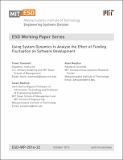| dc.contributor.author | Trammell, Travis | |
| dc.contributor.author | Madnick, Stuart E. | |
| dc.contributor.author | Moulton, Allen | |
| dc.date.accessioned | 2016-06-07T00:00:58Z | |
| dc.date.available | 2016-06-07T00:00:58Z | |
| dc.date.issued | 2014-10 | |
| dc.identifier.uri | http://hdl.handle.net/1721.1/103025 | |
| dc.description.abstract | Almost everyone understands that budget fluctuations have an impact on software development, but it is difficult to estimate the magnitude of the impact and all the causes. This paper uses System Dynamics modeling to examine how gaps in funding affect software development productivity and product delivery delay. The results provide decision makers with an improved sense of the negative impacts of budget fluctuations. Two key insights include the “ramp up tax” that slows development and the “gap tax” due to the loss of project-related skill and familiarity when employees are transferred off of a project and then return. The model experiments also compare the different impacts of temporarily stopping a project versus stretching out a project by temporarily reducing the funding level. | en_US |
| dc.language.iso | en_US | en_US |
| dc.publisher | Massachusetts Institute of Technology. Engineering Systems Division | en_US |
| dc.relation.ispartofseries | ESD Working Papers;ESD-WP-2014-32 | |
| dc.title | Using System Dynamics to Analyze the Effect of Funding Fluctuation on Software Development | en_US |
| dc.type | Working Paper | en_US |
